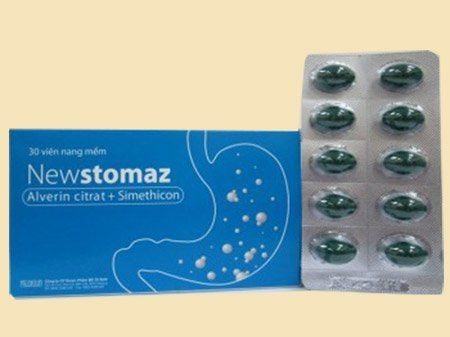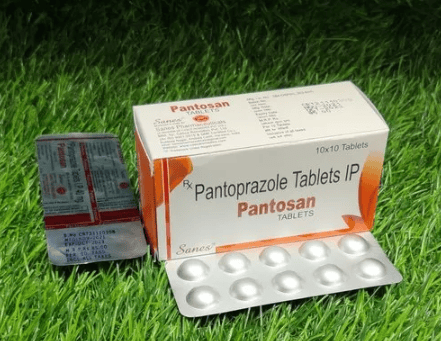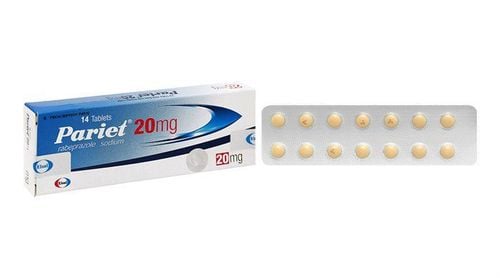This is an automatically translated article.
Rabol is an injectable medication that is only used in adults to relieve symptoms of peptic ulcer disease, gastroesophageal reflux disease, and gastroesophageal reflux disease. So when using Rabol, patients need to pay attention to what problems?1. What are the uses of Rabol?
1.1. What is Rabol? Rabol is a Gastrointestinal drug with the ingredient Rabeprazole 20mg. Each vial contains: Rabeprazole 40 mg.
Each ampoule of solvent for injection contains: water for injection (just enough) 5 ml.
Rabol medicine is prepared in the form of coagulant powder for intravenous injection
1.2. What does Rabol do? Suppression of gastric acid secretion: Rabeprazole sodium inhibits gastric acid secretion stimulated by dibutyl cyclic AMP in the gastric glands of isolated rabbits (in vitro). Rabeprazole sodium strongly inhibits gastric acid secretion stimulated by histamine or pentagastrin.
Anti-ulcer activity: In rats, rabeprazole sodium has been shown to have potent anti-ulcer effects on a variety of ulcers and ameliorate experimental gastric mucosal lesions (cold stress, water immersion stress). , pyloric ligation, cysteine or ethanol-HCl). Rabol is indicated in gastroesophageal reflux disease, duodenal ulcer and Zollinger-Ellison syndrome.
2. How to use Rabol
2.1. How to take Rabol Rabeprazole tablets should be swallowed whole, without crushing, breaking or chewing. Drink when full or hungry.
2.2. Dosage of the drug Rabol Adults:
Acute gastric - duodenal ulcer: The usual dose is 20 mg / time / day. Then continue at 10 mg - 20 mg daily depending on response. Gastro-esophageal reflux syndrome: 10 - 20 mg/time/day Zollinger - Ellison syndrome: Adults, starting dose is 60 mg/day. The dose may be increased to a maximum of 60 mg twice daily depending on the need for the individual patient. Patients with hepatic and renal impairment: No dose adjustment is required. Rabeprazole enteric-coated film-coated tablets should be swallowed whole. Do not chew, crush or break the tablet. Rabeprazole enteric-coated film-coated tablets may be taken with or without food.
Handling missed dose: Information on how to handle a missed dose is being updated. If you think you have missed a dose, tell your doctor as soon as possible.
Treatment of overdose: Symptoms of overdose are unknown. The drug was still well tolerated when a dose of 240 mg intravenously over 2 minutes. The drug is bound to plasma proteins and cannot be removed by dialysis. In case of drug overdose, treatment should be symptomatic and supportive, there is no specific treatment.
3. Notes when using Rabol
Rabeprazole can cause interstitial nephritis. Treatment with rabeprazole for a long period of time (eg, more than 3 years) can lead to malabsorption of cyanocobalamin (vitamin B-12), diarrhea, and an increased risk of osteoporosis and bone fractures. Therefore, patients should receive rabeprazole at the lowest dose for the shortest time.
Pregnant women: There are no adequate studies in pregnant women. The drug should only be used when the potential benefits outweigh the potential risks to the fetus.
Nursing mothers : It is not known whether rabeprazole is excreted in human milk. Because many drugs are excreted in milk, caution should be exercised when rabeprazole is administered to a nursing woman.
Children: Do not use rabeprazole in pediatric patients under 1 year of age.
Elderly: Use with caution in elderly patients because some people are more sensitive to rabeprazole than younger people.
4. Side effects of the drug Rabol
Whole body: fever, aches, fatigue, malaise, abdominal distension. Cardiovascular: chest pain or angina, increased or decreased heart rate, palpitations, increased blood pressure, peripheral edema. Metabolism/nutrition: hypoglycemia, weight gain. Muscles: cramps, muscle pain, joint pain and leg pain. Nervous system: psychological disturbances including depression, impatience, hallucinations, hallucinations, sleeping eyes, restlessness, tremors, apathy, daydreams, anxiety, abnormal dreams, paresthesias, dysesthesias . Respiratory: nosebleeds and sore throat. Skin: dermatitis, rash, angioedema, urticaria, itching, hair loss, dry skin, hyperhidrosis. Strange sensations: tinnitus, strange mouth. Urogenital - genitourinary: urinary tract infection, pyuria, urinary frequency, increased serum creatinine, proteinuria, diabetes, testicular pain, gynecomastia in male patients. Hematology: Agranulocytosis was observed in a male over 65 years of age with diabetes receiving multiple drugs with rabeprazole. The relationship between rabeprazole and agranulocytosis is unclear. Pancytopenia, thrombocytopenia, neutropenia, leukocytosis, hemolytic anemia.
5. Rabol drug interactions
Rabeprazole increases the effectiveness of the anticoagulant warfarin (Coumadin). Rabeprazole reduces the elimination of cyclosporin in the liver, thereby increasing blood concentrations of cyclosporin and potentially leading to cyclosporin toxicity. The absorption of some drugs can be affected by changes in stomach acid levels. Rabeprazole reduces the absorption and blood concentrations of ketoconazole (Nizoral), increases the absorption and blood concentrations of digoxin (Lanoxin), leading to decreased effectiveness of ketoconazole or digoxin toxicity. Rabeprazole may decrease the blood level of atazanavir (Reyataz).
In short, Rabo drug is effective in treating symptoms of peptic ulcer disease, gastroesophageal reflux disease. When using the drug, the patient should carefully read the instructions for use and consult the doctor to get the best results.
Please dial HOTLINE for more information or register for an appointment HERE. Download MyVinmec app to make appointments faster and to manage your bookings easily.













